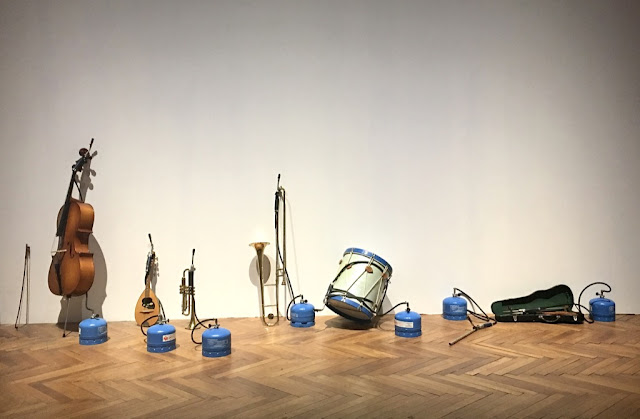Ca Corner della Regina – Fondazione Prada
Jannis Kounellis
At the Fondazione Prada, until November 24, Jannis Kounellis, curated by Germano Celant, is the major
retrospective dedicated to the artist following his death in 2017. Developed in
collaboration with Archivio Kounellis,
the project brings together more 60 works from 1959 to 2015. The show explores
the artistic and exhibition history of Jannis Kounellis (Piraeus 1936 – Rome
2017), establishing a dialogue between his works and the eighteenth-century spaces
of Ca’ Corner della Regina. Kounellis
participated in exhibitions that paved the way to Arte Povera, which in turn translated into an authentic form of
visual expression. An approach that recalls ancient culture, interpreted according
to a contemporary spirit, in contrast with the loss of historical and social
identity that took place during the postwar period.
Senza Titolo – coat, hats shoes – 2011
Germano
Celant
curator
The artist’s early works, originally exhibited between 1960 and 1966,
deal with urban language. These paintings reproduce actual writings and signs
from the streets of Rome. Later on,
the artist transferred black letters, arrows and numbers onto white canvases,
paper or other surfaces, in a language deconstruction that expresses a
fragmentation of the real.
Senza
Titolo
– oil on canvas -1960
Senza
Titolo
– bottles plywood -1959
Senza
Titolo –
1969
Jannis
Kounellis
Photograph and
copyright Manfredi Bellati
Senza Titolo -
iron – newspaper, wool, wood – 1987
The spectacular
large-scale installations, realized in the exhibition by Kounellis from the end of the 1980s, whose ensembles envelop
shelves or metal constructions containing objects of various origins: from
musical instruments to sacks, from plaster casts to stones, from coats to
glasses, from mechanical gears to fragments of furniture.
Senza
Titolo
– iron, stones, cloth, steel, burlap, coal, wool, sewing machines, coats,
marble, ceramic – 2013
Senza Titolo – Iron enamel – 1994
Photograph and
copyright Manfredi Bellati
The large room of the second floor hosts an
intervention from 1993-2008 made up of different colored closets and forms
hanging from the ceiling. Conceived for the first time for the spaces of Palazzo Belmonte Riso in Palermo, the work challenges the laws
of gravity and, through the series of casually opened doors, seems to imitate
the impossible perspectives of baroque painting.
Senza
Titolo
Senza
Titolo
– lead rolls – 2004
Senza
Titolo
– iron shelves, bags, plaster – 1999 - detail
An investigation into the olfactory, which
began in 1969 with coffee, continued through the 1980s with elements like
grappa, in order to escape the illusory limits of the painting, embrace the
world of the senses and join with the virtual chaos of reality.
Senza Titolo – iron, coffee – 2013
“I have always been fascinated by music. I played the violin when I was very young. I
began with a one-quarter violin so I really must have been very young. I later gave it up, but the image of the
violin has always remained in my mind’s eye and I use it everywhere.”
The two works
from 1980 and 2006, composed of musical instruments connected to gas cylinders
and wrought iron bells, are ideally connected to two works dated 1971. In the
first case, several flutists play a fragment of Johann Sebastian Bach’s St
Matthew Passion, while in the second an oil painting portrays the notes of
another sacred composition by Bach, this time played live by a violoncellist.
With these two operations, Kounellis
renews the sacred dimension of music connected to the myth of Orpheus, which attributes the ability
to convert inert objects into living things to music, thus placing it in
opposition to death.
Senza
Titolo
These works
substitute or connect the image with sound, overcoming the traditional
distinctions between artistic languages. The repetition of musical fragments
and the physical presence of musicians allow the artist to explore once again
the corporeal dimension of the work, as well as the sharing of a conceptual and
sensorial experience between the author and the viewer.
Senza Titolo
Senza Titolo – table, bells – 2006
Throughout his
artistic research Kounellis develops
a tragic and personal relationship with culture and history, avoiding a refined
and reverential attitude. He would eventually represent the past with an
incomplete collection of fragments, as in the work from 1974 made up of
portions of plaster casts of classical statues laid out on a table and
accompanied by a lit paraffin lamp. Meanwhile, in other works the Greco-Roman heritage is explored
through the mask, as in the 1973 installation made up of a wooden frame on
which plaster casts of faces are placed at regular intervals. This wooden
support encloses a canvas that evokes a theatrical space in which the mask,
according to Greek tradition, establishes the role and identity of the
character, defining its origins and destiny.
Senza Titolo
At the height
of the mutation and sublime result of combustion, according to alchemical
tradition, we find gold, employed by the artist in multiple ways. In the
installation Untitled - Tragedia Civile
- 1975, the contrast between the gold leaf that completely covers a bare wall
and the black clothing hanging on a coat hanger underlines the dramatic nature
of a scene that alludes to a personal and historical crisis. It is a
self-portrait of the artist, here sacrificed and therefore absent, expressing
the suffering of an existential and creative condition. A division between past
and present that still retains some hope of coming back together again, as the
presence of the lit acetylene lamp suggests.
Senza Titolo – Tragedia Civile
gold-leaf-coated wall, coat rack, coat, hat, gas lamp – 1975
Senza Titolo – hat, golden leaves - 1972
Pin It























